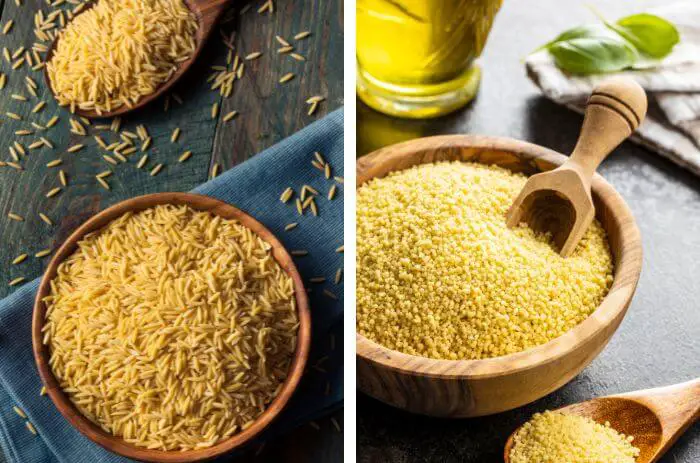So, you’re in the mood for some delicious grains, but you find yourself torn between two contenders: Orzo and Couscous. It’s a classic showdown in the world of culinary choices, and we’re here to help you make the ultimate decision. Strap in and prepare for a grainy showdown of epic proportions!
The Contenders: Orzo
Orzo, also known as “the pasta that looks like rice,” is a bit of a shape-shifter. It’s essentially tiny pasta, but it often gets mistaken for rice due to its size and shape. Crafted from durum wheat, it’s packing some serious protein and gluten power. Orzo can be a bit of a show-off, appearing in various colors like pale yellow, white, and even some more vibrant options like red, orange, or green, thanks to the magic of food coloring.
Texture Check: Orzo is like a tiny pasta with a chewy, nutty vibe. It’s a real team player in the kitchen, ready to cozy up to other ingredients and make dishes pop.
The Challenger: Couscous
Couscous, on the other hand, hails from North Africa and Morocco, and it’s here to give Orzo a run for its money. Couscous is made by crushing durum wheat semolina into tiny granules or balls. Like Orzo, it comes in various sizes, from teeny-tiny to somewhat less tiny.
Texture Check: When cooked, Couscous fluffs up and becomes all light and fluffy, like a cloud made of grains. It’s got a milder flavor, which means it’s pretty open to flavor infusions from other ingredients.
Orzo Vs. Couscous
Round 1: Versatility
Orzo: Orzo doesn’t shy away from the spotlight. It’s a versatile ingredient that can slide into a wide range of dishes, whether as a sidekick or the main event. Here are some of its favorite gigs:
- As a side dish: Swap out your rice or potatoes for some orzo. You can enjoy it plain or jazz it up with herbs, spices, or sauces.
- In soups: It’s a soup sensation, especially in classics like chicken noodle soup. Orzo adds that extra oomph to your soup game.
- In salads: Orzo can shine in pasta salads or grain salads. Throw in some veggies, herbs, or meats, and you’ve got yourself a delightful salad.
- In casseroles: Looking to switch things up? Orzo can replace other pasta or rice in casseroles, and it pairs beautifully with cheese, veggies, or meats.
- As a main dish: Orzo doesn’t mind taking center stage. Mix it up with sauces, veggies, and meats, and you’ve got a main course ready to dazzle.
Couscous: Couscous is no slacker in the versatility department either. It knows how to wear many hats:
- As a side dish: Serve Couscous alongside your meats, veggies, or sauces.
- In stews: Couscous is a superstar in stews, particularly in North African and Middle Eastern cuisines.
- In salads: Just like Orzo, Couscous can play nice in salads, especially when paired with fresh veggies and herbs.
- In desserts: Couscous isn’t just for savory dishes. It can sweeten your day in desserts like Couscous pudding or Couscous cake.
- As a main dish: Couscous can step up and be the star of the show when mixed with veggies, meats, and sauces.
Round 2: Nutritional Showdown
Both Orzo and Couscous are wheat-based, so you can expect some similarities. But there are a few key differences you should know:
Orzo: This durum wheat wonder is a champ when it comes to complex carbs, fiber, and protein. It’s low on the fat and sodium scale. But here’s the catch: it’s not gluten-free, so if you’re a gluten-sensitive individual, you might want to give it a pass.
Couscous: Couscous, also made from semolina flour, isn’t quite as packed with fiber and protein as Orzo. It’s also low in fat and sodium and, like its pasta counterpart, it’s not suitable for the gluten-intolerant crowd.
If you’re aiming for a healthier option, consider whole wheat orzo. It’s the nutritional overachiever in this battle, with more fiber and nutrients than regular orzo.
In terms of calories, the two contenders are closely matched. A cup of cooked orzo serves up around 200 calories, while couscous weighs in at about 170 calories per cup.
Round 3: Texture and Flavor Face-Off
Orzo: Orzo struts its stuff with a unique texture that sets it apart. It’s rice-like but slightly larger and has a more tender bite. Plus, it boasts a nutty flavor that loves to mingle with various ingredients.
Couscous: Couscous, on the flip side, is a different ballgame. It’s all about those tiny granular pellets, similar in size to rice grains. When cooked, it transforms into a fluffy cloud-like texture. Its flavor is on the mild side, ready to play second fiddle to other flavors you introduce.
Round 4: Cooking Showdown
Orzo: Cooking up orzo is a breeze, just like any other pasta. Bring a pot of salted water to a boil, toss in your orzo, and let it dance in there for about 8-10 minutes or until it’s got that perfect al dente vibe. Drain it, rinse it under cold water to halt the cooking, and you’re good to go.
Couscous: Couscous, in its traditional form, is steamed to perfection. You’d need a fancy gadget called a couscoussier for the full experience. In this device, you’d fill the bottom with water and bring it to a boil. Then, you’d add the couscous to the top compartment and steam it for 10-15 minutes, giving it an occasional stir. Alternatively, you can cook it by adding it to a pot of boiling water, removing it from the heat, and letting it chill for 5-10 minutes until it soaks up the water.
The Verdict
In the end, the choice between Orzo and Couscous comes down to your culinary desires. Are you in the mood for the nutty, chewy versatility of Orzo, or the fluffy, mild-mannered Couscous that’s ready to soak up whatever flavors you throw its way?
One thing’s for sure: whether you’re crafting a Mediterranean masterpiece or diving into a North African adventure, both Orzo and Couscous are ready to be your kitchen companions. So, let your taste buds be your guide, and may your grainy adventures be delicious!
Now, go forth and conquer your next culinary creation, armed with the knowledge of Orzo vs. Couscous. Happy cooking!



